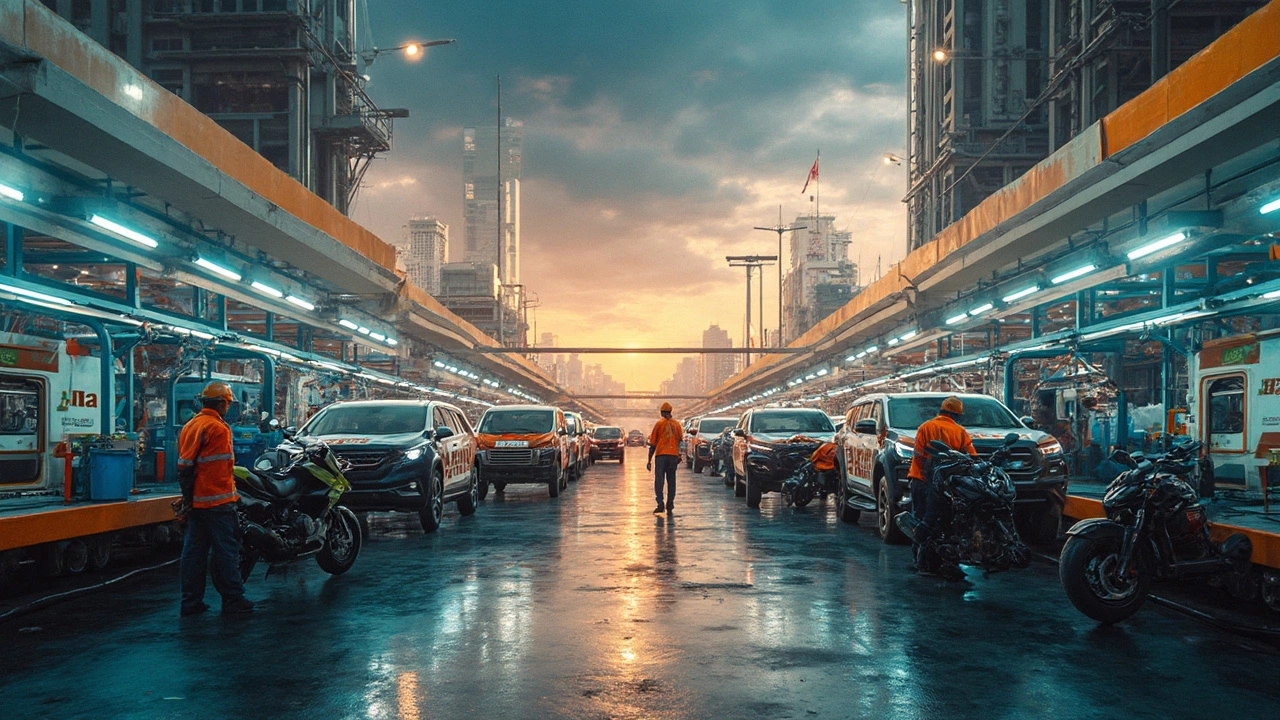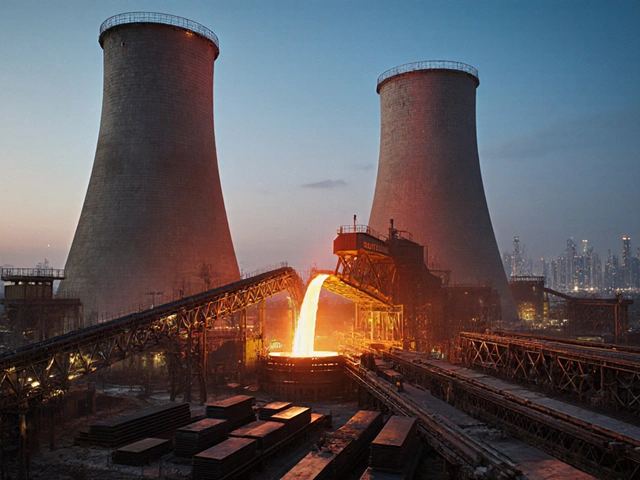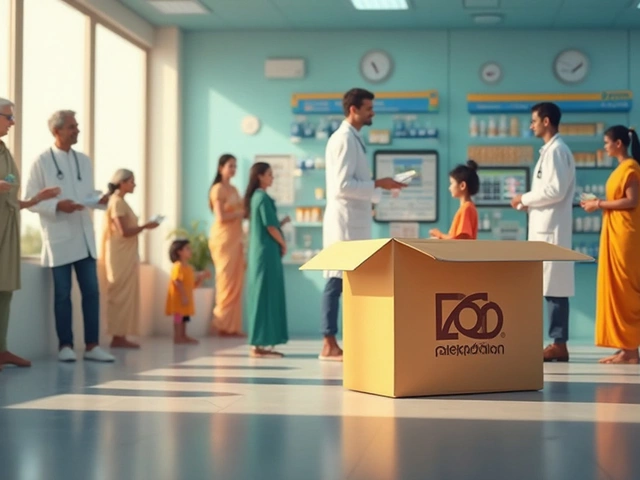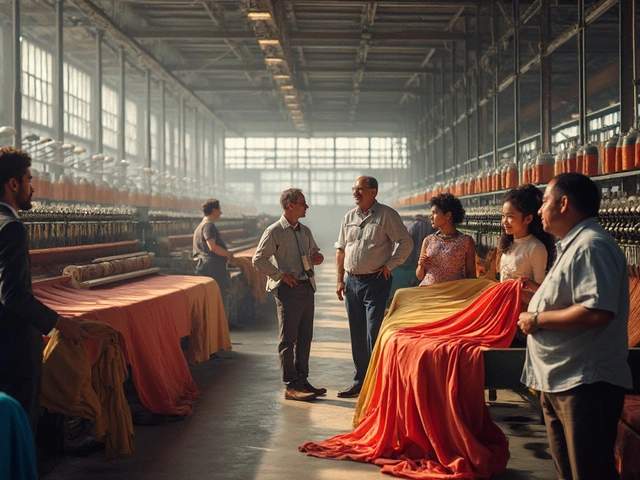India doesn’t just assemble cars—it fully manufactures them, from small hatchbacks to massive trucks and everything in between. Major brands, some you see every day and others you’ve probably never heard of, have massive factories across the country. These are not just tin sheds either—think high-tech plants, cutting-edge robotics, and thousands of skilled workers making vehicles right from the ground up.
If you’re driving through Delhi, Bangalore, or Mumbai, chances are you’re surrounded by cars and bikes built in India. The funny part? You don’t even need to look for 'Made in India' badges—many vehicles rolling off Indian assembly lines find their way to Europe, Africa, and Latin America. That means the car you see zipping through Mexico City or the compact SUV parked in Rome might have started life somewhere outside Pune or Chennai.
Curious about why India produces so many vehicles? It’s not just about local need. Indian manufacturers cracked the code on making affordable, reliable, and fuel-efficient cars for huge numbers of buyers. And with export numbers soaring—India shipped out over 7 million vehicles last year alone—it’s clear the rest of the world likes what rolls out of Indian factories, too.
- India’s Homegrown Automobile Industry
- Major Car and Bike Makers in India
- Popular Cars and Vehicles Built in India
- How Indian Automobiles Compete Globally
- Cities and Hubs Driving Production
- Useful Tips for Buying Indian-made Vehicles
India’s Homegrown Automobile Industry
If you think of automobile manufacturing in India, picture more than just putting parts together. India runs the full show—designing, engineering, making engines, pressing car bodies, painting, and even cranking out the final checks. It's not only about quantity, but also about in-house know-how and self-reliance. Indian brands like Tata Motors and Mahindra & Mahindra lead the pack with vehicles built almost completely from local components.
The story goes way back, too. Hindustan Motors started local car production in the 1940s. The real boom happened after the 1990s, when big reforms let the industry spread its wings. Since then, the sector has exploded. India has become the world’s third-largest vehicle producer, right behind China and the US. You’ll find everything here—bikes, scooters, hatchbacks, fancy SUVs, trucks, and even electric vehicles, all rolling off Indian assembly lines.
Why so much action in Indian car industry? One simple reason: local demand. With a population of 1.4 billion and a middle class always eyeing their first set of wheels, companies have a built-in customer base. But the export story is real, too. India sends out cars and two-wheelers to over 100 countries. Global carmakers partner with Indian giants for low-cost, high-quality production.
| Year | Vehicles Produced | Vehicles Exported |
|---|---|---|
| 2022 | 25 million | 5.6 million |
| 2023 | 28 million | 7.1 million |
There’s a solid push for green mobility, too. Indian companies have begun rolling out electric scooters, tuk-tuks (rickshaws), and small EV cars at prices that even first-timers can afford. That’s a big step for both local roads and global climate action. Factories in cities like Pune, Chennai, and Gurgaon don’t just serve India—they build for the world, offering jobs to millions and raising India’s global status as a car manufacturing heavyweight.
Major Car and Bike Makers in India
When you talk about automobile manufacturing India, a handful of names always pop up first. Maruti Suzuki easily tops the list—it’s not just the biggest car manufacturer in India, but also one of the most trusted. Their Alto, Swift, and Dzire models are everywhere. Tata Motors is another heavyweight, famous not only for cars like the Nexon and Harrier but also for building trucks and even buses that you see rolling across the country.
Want something more global? Hyundai, a South Korean brand, churns out millions of cars like the i20 and Creta from plants in Chennai and sells them both locally and abroad. Mahindra & Mahindra nails it with rugged SUVs and utility vehicles. Their Thar and Bolero models are legendary among rural and adventure-loving crowds.
The bike scene is just as packed. Think Hero MotoCorp—probably the largest two-wheeler maker in the world by numbers. Their Splendor and Passion bikes are household names. Bajaj Auto can’t be ignored either; its Pulsar series rides everywhere, and their famous RE auto-rickshaw is practically a brand by itself in the streets of every Indian city.
Let’s make it clear who’s who with a quick look:
| Brand | Type | Popular Models | Known For |
|---|---|---|---|
| Maruti Suzuki | Cars | Alto, Swift, Dzire | Affordability, reliability |
| Tata Motors | Cars, Trucks | Nexon, Safari, Ace | Sturdy vehicles, electric cars |
| Hyundai India | Cars | i20, Creta, Verna | Modern features, exports |
| Mahindra & Mahindra | SUVs, Utility | Thar, XUV700, Bolero | Rugged, off-roaders |
| Hero MotoCorp | Motorcycles | Splendor, Passion, HF Deluxe | High mileage, largest volumes |
| Bajaj Auto | Bikes, Rickshaws | Pulsar, Platina, RE Rickshaw | Performance bikes, exports |
Did you know over 70% of new cars sold in India carry the Maruti badge? Or that Hero MotoCorp sells more bikes each month than entire car industries in some small countries? If you’re car shopping or just curious, knowing these major names helps you figure out what drives the Indian roads and what’s showing up in export markets worldwide.
Popular Cars and Vehicles Built in India
When it comes to automobile manufacturing India, the list of popular vehicles built here is seriously impressive. The country pumps out everything from tiny hatchbacks to big SUVs and even commercial trucks and buses. You’ve probably heard of brands like Maruti Suzuki, Tata Motors, Hyundai, and Mahindra—they’re the engines behind most Indian roads.
Here’s a quick look at some top models that define the Indian car scene:
- Maruti Suzuki Alto: Arguably the most common car on Indian roads. It’s cheap to run, ultra-reliable, and surprisingly roomy inside for its small size.
- Hyundai Creta: If you love SUVs, the Creta is everywhere in India. It’s got a loyal fan base because of its style, comfort, and mileage.
- Tata Nexon: Known for its safety and cool design, the Nexon is a favorite among young buyers and families alike.
- Mahindra Bolero: This one’s tough as nails. Farmers, small business owners, and even police forces rely on it for rough roads and heavy loads.
- Tata Ace: Not a car, but a mini truck you’ll spot hauling just about anything—groceries, furniture, you name it. It’s the go-to workhorse for small businesses.
Don't forget two-wheelers—India is the world’s biggest producer of bikes and scooters. Hero MotoCorp, Bajaj, and TVS crank out millions of bikes like the Splendor, Pulsar, and Apache, making commuting cheap and easy for millions.
| Top Vehicles Exported from India (2024) | Approximate Units Exported |
|---|---|
| Hyundai i10/i20 | 150,000+ |
| Kia Seltos | 80,000+ |
| Ford EcoSport | 60,000+ |
| Maruti Suzuki Baleno | 55,000+ |
| Bajaj Pulsar (Bike) | 160,000+ |
Thanks to Indian car industry expertise, many of these cars don’t just stay within the country—they’re shipped all over. That tight quality control and focus on mileage make Indian-built wheels a smart pick both at home and abroad.
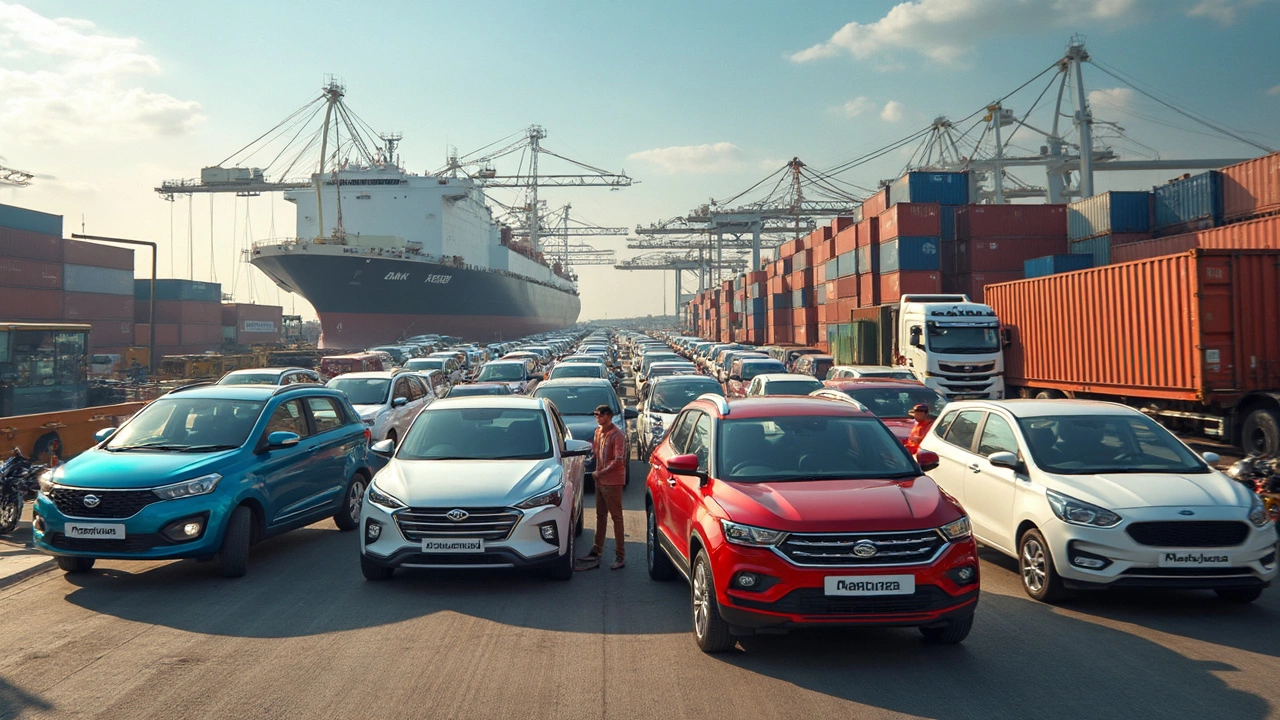
How Indian Automobiles Compete Globally
When you check out global car sales numbers, you’ll start to see a growing chunk of vehicles that are actually made in India. The big players like Maruti Suzuki, Tata Motors, and Mahindra & Mahindra don’t just sell cars on home turf—they export them like crazy. Last year, India exported more than 7 million vehicles, and it’s not just budget cars. You’ll find Indian-made Automobile manufacturing India products in over 100 countries, including the UK, South Africa, Indonesia, and even some parts of Europe.
Indian vehicles are praised globally for hitting a sweet spot—low production costs, reliable performance, and jaw-dropping fuel efficiency. It makes them perfect for markets where people want simple, rugged, and low-maintenance cars and bikes. For example, the Maruti Suzuki Alto and Hyundai i20 built in India are sold with almost no changes in several other countries. Mahindra’s rugged SUVs and tractors are a hit in the U.S. and Africa.
Let’s look at some numbers that show how Indian cars stack up around the world:
| Company | Key Exported Models | Main Markets | 2024 Export Volume |
|---|---|---|---|
| Maruti Suzuki | Baleno, Swift, Dzire | Latin America, Africa, Europe | 270,000+ |
| Tata Motors | Tiago, Nexon | South Africa, Middle East | 90,000+ |
| Hyundai India | i10, i20, Creta | Europe, South America | 150,000+ |
| Mahindra & Mahindra | Scorpio, XUV300 | USA, Africa | 60,000+ |
So why do foreign buyers pick Indian-built vehicles? First, strict global safety and emission standards. Factories here are constantly upgrading tech to pass those extra-tough European and Latin American rules. Second, Indian automakers are fast learners—they adapt quickly. If an overseas market asks for a left-hand drive or unique paint color, local teams get it done without stalling the assembly line.
Another cool thing: India is a secret source for electric vehicles and auto components. Companies like Tata Motors have started exporting electric cars and buses. Plus, if you pop the hood on a Volkswagen or Ford in Germany, there’s a chance some parts were made in Chennai, Pune, or Gurgaon!
If you’re thinking about value for money, Indian cars are often way cheaper than their European or Japanese rivals but don’t skimp on features. That’s why car rental companies and taxi services worldwide now go for Indian vehicles—they spend less, get more, and maintenance is a breeze.
Cities and Hubs Driving Production
If you’re wondering where the heart of automobile manufacturing India beats, think Chennai, Pune, and Gurgaon. These cities don’t just crank out cars and bikes—they’ve become massive ecosystems for the whole auto industry. Car companies, suppliers, tech parks, and even colleges shape these hubs, making them magnets for jobs and investment.
Chennai is famous as the “Detroit of India.” It’s not just a cool nickname. Big names like Hyundai, Ford (for exports), Renault-Nissan, and Ashok Leyland all picked Chennai for a reason. You’ve got easy port access, lots of skilled workers, and pretty straightforward logistics. About 35% of India’s car exports come straight out of Chennai.
Pune is another heavyweight. The city is buzzing with brands like Tata Motors, Mahindra & Mahindra, Mercedes-Benz India, and Bajaj Auto. Pune also has close ties with research and engineering colleges, so companies can find the right talent without breaking a sweat. Pro tip: this is the spot for new models to be tested first.
Gurgaon (now Gurugram) and the wider NCR region have become a powerhouse for Indian car industry. If you’ve seen a Maruti Suzuki or Hero MotoCorp bike on the road, chances are it was made in or near this region. Gurgaon is all about volume—no surprise, since Maruti Suzuki rolls out more than 1.5 million cars here every year.
| City/Region | Major Brands | Unique Strength |
|---|---|---|
| Chennai | Hyundai, Renault-Nissan, Ford, Ashok Leyland | Port access, big car exports |
| Pune | Tata Motors, Bajaj Auto, Mercedes-Benz India | Research links, lots of engineering talent |
| Gurgaon/NCR | Maruti Suzuki, Hero MotoCorp | Largest car volumes, supplier ecosystem |
Other places like Sanand (in Gujarat), Hosur (Tamil Nadu), and Noida (Uttar Pradesh) have been catching up fast, thanks to newer facilities by Honda, Suzuki, and MG Motor. These cities may not have the legacy yet, but they’re pushing India’s vehicle production numbers higher every year.
Useful Tips for Buying Indian-made Vehicles
If you’re thinking about picking up a vehicle made in India, there are a few things to make life easier—and safer. First, always double check where your car or bike is actually assembled. Top Indian car industry players like Maruti Suzuki, Tata Motors, and Mahindra produce most of their lineup right in India, so you’ll be dealing with vehicles built for local conditions and repair systems.
Want reliability? Models like the Maruti Suzuki Swift, Tata Tiago, and Hyundai Creta have proven track records for both city and highway use. If you’re after a two-wheeler, the Bajaj Pulsar and TVS Apache are favorites for a reason—solid performance, affordable parts, and a service network that covers even smaller towns.
- Spare parts and service: Indian-made vehicles mean quick access to cheap, genuine spares. Brands like Mahindra and Hero MotoCorp have massive networks—no waiting weeks for a basic part.
- Resale value: Cars and bikes from Maruti Suzuki, Tata, and Hyundai generally hold their value better, since they’re everywhere and people trust them.
- Check for safety features: Not every made-in-India car has top-notch safety. Always look for ABS, airbags, and if possible, recent Global NCAP safety ratings. Tata and Mahindra, for example, now make several models with good crash-test scores.
- Fuel economy: Indian vehicles are built with high mileage in mind. Check the claimed km/l on the sticker, but also look up real-user reviews for the numbers people actually get in city traffic.
- Exports and build quality: Many Indian factories export the same cars you see here to Europe and Africa—especially models like Hyundai i20 and Kia Sonet. That means higher build quality, since export models go through stricter checks.
If you’re buying used, match the car’s VIN with its records—the government’s Vahan portal makes this easy. This small step helps avoid headaches from dodgy paperwork or unpaid loans.
Here’s a quick look at service and spare part network points for key brands:
| Brand | Service Centers (approx.) | Spare Part Dealers |
|---|---|---|
| Maruti Suzuki | 3,500+ | 5,000+ |
| Hyundai | 1,300+ | 3,500+ |
| Mahindra | 1,200+ | 3,200+ |
| Tata Motors | 1,000+ | 2,700+ |
Bottom line: Buy a vehicle made in India and you’ll save on parts, get easy service access, and drive something tested for Indian roads. Just do a bit of research, prioritize safety, and always test-drive before sealing the deal.

